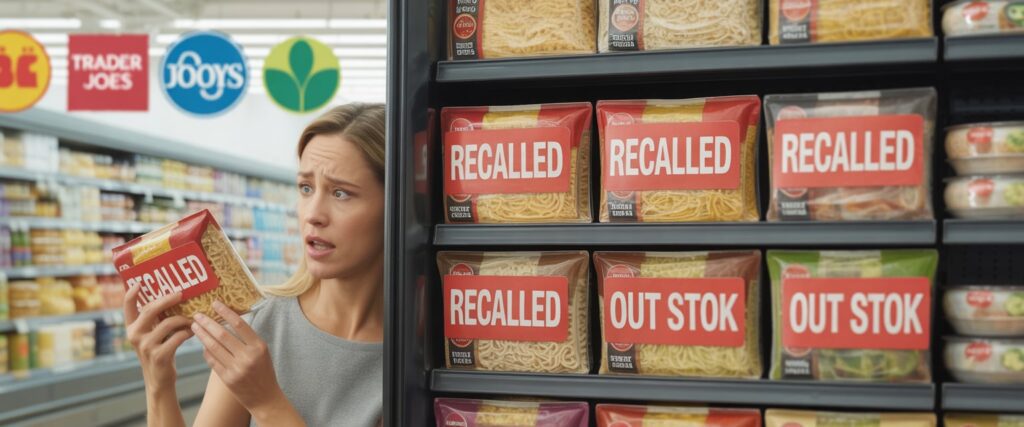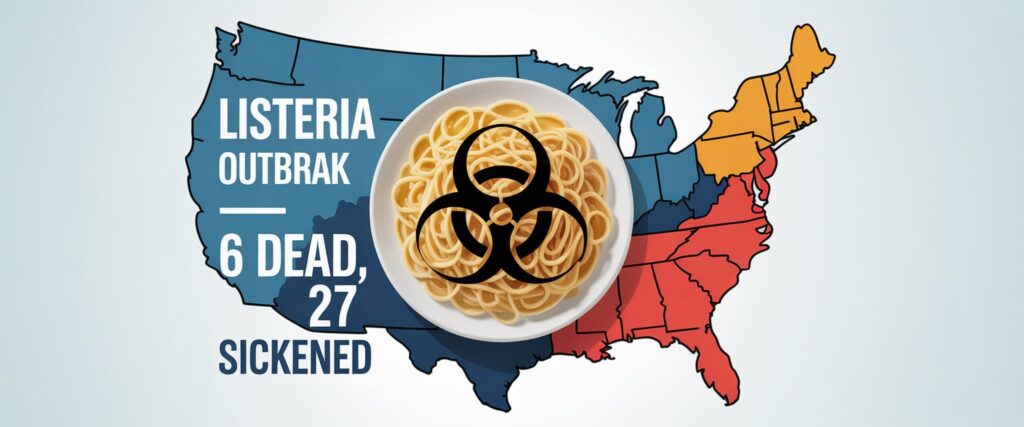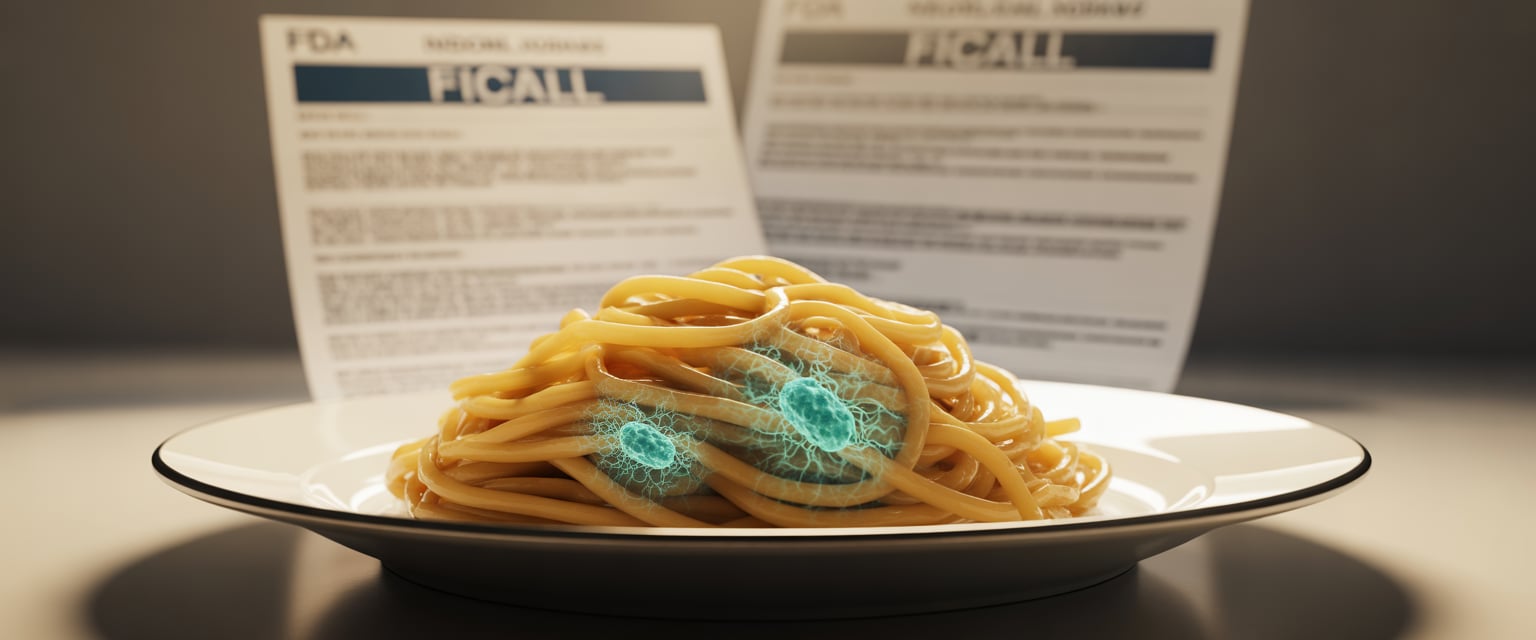The recent Listeria Outbreak: 6 Dead After Eating Recalled Pasta Meals has sparked nationwide concern among consumers and public health officials. Prepared pasta meals from major grocery chains—including Trader Joe’s, Albertsons, and Kroger—have been linked to a deadly bacterial contamination that has already claimed six lives and sickened dozens across 18 states.
Health authorities are racing to trace the contamination source and prevent further cases. The Listeria Outbreak: 6 Dead After Eating Recalled Pasta Meals serves as a grim reminder of how dangerous foodborne bacteria can be, especially in ready-to-eat products trusted by millions of households.
Listeria Outbreak: 6 Dead After Eating
Prepared pasta meals sold at major grocery stores have been linked to a deadly listeria outbreak that has sickened 27 people across 18 states. Six people have died after eating contaminated pasta meals recalled from stores like Albertsons, Trader Joe’s, Kroger, and Sprouts Farmers Market. Federal health officials say the outbreak continues to grow as they work to trace the contamination source.
The recalled meals included popular pasta types such as fettuccine, linguine, and farfalle. Nate’s Fine Foods Inc., the supplier, found traces of Listeria monocytogenes in its products, prompting recalls between June and October. Most people who became ill reported eating these ready-to-eat meals before symptoms began.

Health officials are investigating how the bacteria entered the food supply and spread so widely. The Centers for Disease Control and Prevention and the Food and Drug Administration are urging consumers to check their refrigerators and freezers for recalled items to prevent further illness.
Details of the Listeria Outbreak
Federal health officials linked a multistate listeria outbreak to contaminated prepared pasta meals sold at major grocery chains. The outbreak caused several deaths and hospitalizations and led to a nationwide recall of products made by Nate’s Fine Foods Inc.
Number of Cases and Deaths
The outbreak sickened 27 people across the United States. Of those, 25 were hospitalized, and 6 people died after eating prepared pasta meals contaminated with Listeria monocytogenes.
Health officials also reported that a pregnant woman lost her fetus due to the infection. Most people who became ill had eaten pre-cooked or ready-to-eat pasta dishes such as fettuccine, linguine, and farfalle.
The Centers for Disease Control and Prevention (CDC) described this outbreak as one of the more serious recent incidents linked to listeria. The high hospitalization rate showed how dangerous this bacterium can be, especially for older adults, pregnant women, and people with weakened immune systems.
States Affected
Cases were confirmed in 18 states, showing how widely the contaminated meals were distributed. The affected states included:
| Region | States |
|---|---|
| West | California, Hawaii, Nevada, Oregon, Utah, Washington |
| South | Florida, Louisiana, South Carolina, Texas |
| Midwest | Illinois, Indiana, Michigan, Minnesota, Missouri |
| East | North Carolina, Ohio, Virginia |
Health officials said the wide spread of cases reflected the nationwide sale of the recalled products through major grocery chains such as Albertsons, Kroger, Sprouts Farmers Market, and Trader Joe’s.
Because the products were sold under multiple store brands, tracing the source required cooperation between federal and state agencies.
Timeline of the Outbreak
The contaminated pasta meals were recalled between June and October after testing found listeria in samples from Nate’s Fine Foods Inc. The company detected the bacteria during internal testing and reported it to the Food and Drug Administration (FDA) and the CDC.
By late September, the CDC confirmed that illnesses had been reported over several months. The outbreak grew in early fall, prompting expanded recalls and public warnings.
Officials said the investigation remains active as they continue to track additional cases and verify whether all contaminated products have been removed from stores.
Recalled Pasta Products and Retailers
Federal health officials linked the Listeria outbreak to several types of prepared pasta meals sold nationwide. The recall involved products made by Nate’s Fine Foods Inc. and distributed to major grocery chains under different brand labels.
Prepared Pasta Types Involved
The recalled items included a variety of precooked pasta dishes such as fettuccine alfredo, linguine with pesto, farfalle with vegetables, and macaroni with cheese sauce. These meals were sold in refrigerated sections and marketed as ready-to-heat options.
Investigators found Listeria monocytogenes in a sample collected from the manufacturing facility. The contamination likely occurred during packaging or cooling. Many affected products shared the same production line, which increased the risk of cross-contamination.
Consumers were advised to check packaging labels for lot numbers and “use by” dates listed between June and October 2025. Officials urged anyone who purchased these meals to dispose of them immediately or return them for a refund.
Major Grocery Chains Impacted
The recalled pasta meals were distributed to several large retailers across the United States. Stores included Albertsons, Kroger, Sprouts Farmers Market, Trader Joe’s, Safeway, and Whole Foods Market. Smaller regional grocery chains also carried the affected items under private-label brands.
These stores removed the products from shelves once the recall was announced. Most had posted in-store notices and online alerts to inform customers. Some retailers also contacted loyalty program members who had purchased the items.
The wide distribution network contributed to the outbreak’s reach, with 27 confirmed illnesses in 18 states. Health officials said that the variety of store brands made tracing the source more complex, but all were linked to the same supplier.
Recall Actions and Dates
Nate’s Fine Foods Inc. initiated the first recall in late June 2025 after internal testing detected Listeria. The company expanded the recall in July and again in September as additional products tested positive.
The Food and Drug Administration (FDA) and Centers for Disease Control and Prevention (CDC) worked with the company to identify contaminated batches and notify distributors. Retailers were required to remove all affected products and sanitize storage areas.
By October 2025, the recall covered multiple pasta varieties and package sizes. Federal officials continued to monitor the situation and advised consumers to avoid any refrigerated pasta meals produced by Nate’s Fine Foods until further notice.
Source and Investigation
Federal health officials traced the outbreak to a single supplier that distributed prepared pasta meals nationwide. Investigators focused on production practices, contamination points, and communication between agencies and retailers to prevent further illness.
Supplier Identification
Investigators identified Nate’s Fine Foods Inc. as the supplier connected to the contaminated pasta meals. The company, based in California, produced a range of precooked pasta products for major grocery chains, including Albertsons, Kroger, Sprouts Farmers Market, and Trader Joe’s.
The supplier distributed multiple pasta types—fettuccine, linguine, and farfalle—to stores under different brand labels. This wide distribution made tracing the contamination more complex and required coordination between the CDC, FDA, and state health departments.
Records showed that the affected products were produced and shipped between June and October 2025. Once the link to Nate’s Fine Foods was confirmed, the company issued voluntary recalls across all affected retailers. Officials noted that the supplier’s recall covered both retail and food service products.
The company stated it was cooperating fully with federal authorities and reviewing its safety protocols. Production at the facility was temporarily suspended pending further testing and inspection.
Contamination Discovery
The contamination was discovered after routine testing at Nate’s Fine Foods found Listeria monocytogenes in a sample of cooked pasta. The positive test triggered an internal review and immediate notification to federal regulators.
Further testing confirmed that the same strain of Listeria matched samples taken from patients in multiple states. This genetic match helped officials connect the illnesses to the pasta meals.
Investigators examined the facility’s sanitation logs, equipment surfaces, and cooling areas. They found that the bacterium likely persisted in a hard-to-clean area of the production line. Environmental samples taken from drains and processing tables also tested positive.
Officials said that Listeria can survive refrigeration and spread easily in moist environments, making it difficult to eliminate once established. The company implemented deep cleaning, equipment replacement, and staff retraining to address the issue.
Federal and State Response
The CDC and FDA led the investigation with support from state health departments. They used laboratory data, patient interviews, and product distribution records to track the outbreak’s spread.
Officials issued public warnings advising consumers to check recall notices and discard any affected pasta meals. Retailers removed products from shelves and posted recall alerts online and in stores.
The FDA conducted on-site inspections and reviewed the company’s food safety plans. The CDC updated case counts weekly and provided guidance to healthcare providers on identifying and treating Listeria infections.

State agencies monitored reports of new illnesses and tested unopened products from stores and homes. Coordination between federal and state teams helped limit further distribution and identify remaining contaminated batches.
Health officials emphasized the importance of temperature control, hygiene, and regular testing in preventing future outbreaks.
Understanding Listeria Risks
Listeria bacteria can survive in cold, moist environments and contaminate ready-to-eat foods. People who eat contaminated products risk serious illness, especially those who are pregnant, elderly, or have weak immune systems.
How Listeria Spreads in Food
Listeria monocytogenes often spreads through foods that are not cooked before eating. It can grow in refrigerated items such as deli meats, soft cheeses, and prepared meals. Unlike many bacteria, it continues to multiply at refrigerator temperatures.
Contamination can occur during processing, packaging, or storage if equipment or surfaces are not properly cleaned. Once present, the bacteria can spread to other foods through contact.
Common sources include:
- Ready-to-eat meats and salads
- Unpasteurized dairy products
- Prepackaged or cooked meals
Because Listeria thrives in moisture, even small amounts of residue or condensation can help it grow.

Symptoms and Health Impact
Listeria infection, or listeriosis, usually begins with mild flu-like symptoms. These include fever, muscle aches, nausea, and diarrhea. In severe cases, the infection can spread to the nervous system, causing headaches, stiff neck, confusion, or loss of balance.
Certain groups face higher risks:
- Pregnant women: infection can lead to miscarriage, stillbirth, or newborn infection
- Older adults and people with chronic illness: may develop bloodstream or brain infections
Symptoms may appear days or even weeks after eating contaminated food. Early medical attention improves recovery chances.
Prevention and Food Safety Advice
Safe food handling greatly reduces the risk of listeriosis. People should refrigerate foods below 40°F (4°C) and cook meats and leftovers to safe internal temperatures. Washing hands, utensils, and surfaces after handling raw foods prevents cross-contamination.
Key safety steps:
- Avoid unpasteurized milk and soft cheeses.
- Heat deli meats and hot dogs until steaming.
- Keep raw and cooked foods separate.
- Check recall notices regularly.
Consumers should discard any recalled or expired ready-to-eat items. Maintaining clean refrigerators and following storage guidelines helps stop Listeria from growing unnoticed.
The Listeria Outbreak: 6 Dead After Eating Recalled Pasta Meals underscores the critical importance of strict food safety measures, proper storage, and regular product testing. With 27 confirmed illnesses and multiple fatalities, this tragic event highlights how a single contamination can quickly spread nationwide through popular grocery networks.
Consumers are urged to remain alert, check recall notices, and discard any affected pasta meals immediately. Ultimately, the Listeria Outbreak: 6 Dead After Eating Recalled Pasta Meals stands as both a warning and a lesson for food producers and shoppers alike—vigilance and transparency are key to keeping our food supply safe.

